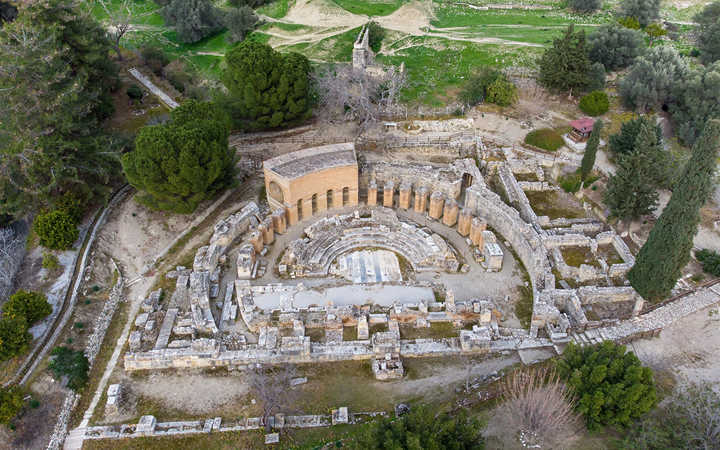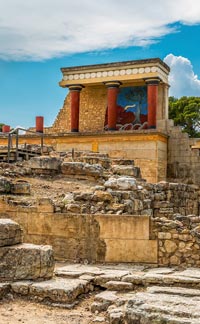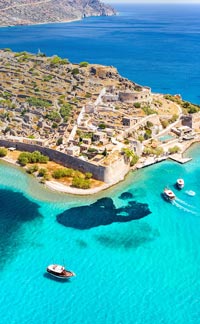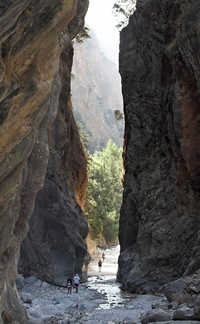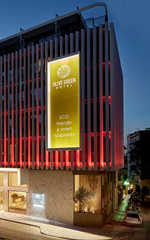Located in the center-south of Crete, 10 km east of her chief rival in antiquity, Phaistos (which Gortyn eventually vanquished after many years of competition and conflict). Gortyn is 40 minutes south of Heraklion, and 12 km north of Crete's south coast. It is Crete's largest archeological site. There is evidence of human habitation there going back to 4,000 BC.
Gortyn was built on a rise of land in the Mesara Plain, which is where Crete was first inhabited. A tradition says the Gortyn was founded by Gortys, the son of Radamanthys, king of Phaistos, who was a brother of King Minos.
Homer mentioned Gortyn, and Plato spoke of it in complimentary terms. Gortyn and nearby Phaistos were rivals. Gortyn gained ascendancy during the 1st millennium BC, while Phaistos was Crete's most important city during the Minoan Era in the previous millennium. Gortyn reached its height of influence and power, however, during the Hellenistic Era (the last 3 centuries BC).
Gortyn had close ties to Ptolemy IV (ruled 221-204 BC) of Egypt, and enjoyed great prosperity under Rome, which made it their capital in Crete in 67 BC, replacing Knossos. It stayed the capital of Crete until Andalusian (Spanish) Arabs, in 828, conquered it (and the rest of Crete), razed it, and moved the capital to Heraklion. In the 6th century a church was built there, named after St. Titus, who was appointed Bishop of Crete by the Apostle Paul. There is evidence of a much earlier church on the same site.
Greek Mythology has a story with its setting in Gortyn, dealing with Zeus and one of his myriad affairs. Disguised as a bull, Zeus abducted the princess Europa from Lebanon, carried her over the water to Gortyn, and had an affair with her under a plane tree. The tree (or one of its descendants) still stands. Three children came of their union: Minos, Rhadamanthys, and Sarpedon, who became kings of 3 palaces in Crete. A large statue of Europa on the back of a bull was found in Gortyn's amphitheatre and now lives in the British Museum. Gortyn struck many coins with the likeness of Europa.
In 1884, what came to be known as the Gortyn Code, or Great Inscription, was found, which led to greater excavations in the vicinity. Excavations continued until 1940. Much of Roman-era Gortyn remains buried.
Gortyn has yielded a treasure trove of archeological items. A settlement on its citadel was uncovered dating to 1050 BC. A temple dating from 700 BC was built on a hill in the citadel. Pottery, embossed plates, black and red figure paintings, and graves were also found in the citadel. In the lower town the market, or Agora, has been uncovered, as well as the temples of Pythian Apollo and Demeter.
The centerpiece of the ancient city is the Praetorium, the seat of the Roman governor of Crete. There are ruins of a temple to Apollo, of Roman baths, of a Roman Theatre, and of a temple worshipping Egyptian deities such as Isis and Serapis. Behind the Roman theatre is the wall with the Gortyn Code inscription.
The Gortyn Code
The oldest and most complete example of ancient Greek law, the Gortyn code was not found all in one piece. Fifteen lines from the 11th column of the 12-column code was found in the wall of a water mill in the village of Agia Deka, 1 km to the east. Twenty years later another 15 lines of the code, this time from the 1st column, were discovered in the wall of a house in the same village. The code was carved on ashlar blocks- large rectangular cut stones set without mortar into a wall. Each block in the top course contains 15 lines of code.
The main code was uncovered by Italian archeologist Frederico Halbheer in 1884. It was an electrifying discovery- considered the most important archeological find of the 19th century. The code had been originally set in a circular wall in a room used for public assembly (ekklesisterion or voulefterion). The wall was 10 m long and 1.5 m high, containing 600 lines of text. Dealing with civil matters, including laws of inheritance and various penalties for different forms of adultery according to societal class, it is dated to mid-400's BC. An English translation of the law is about 1500 words long.

